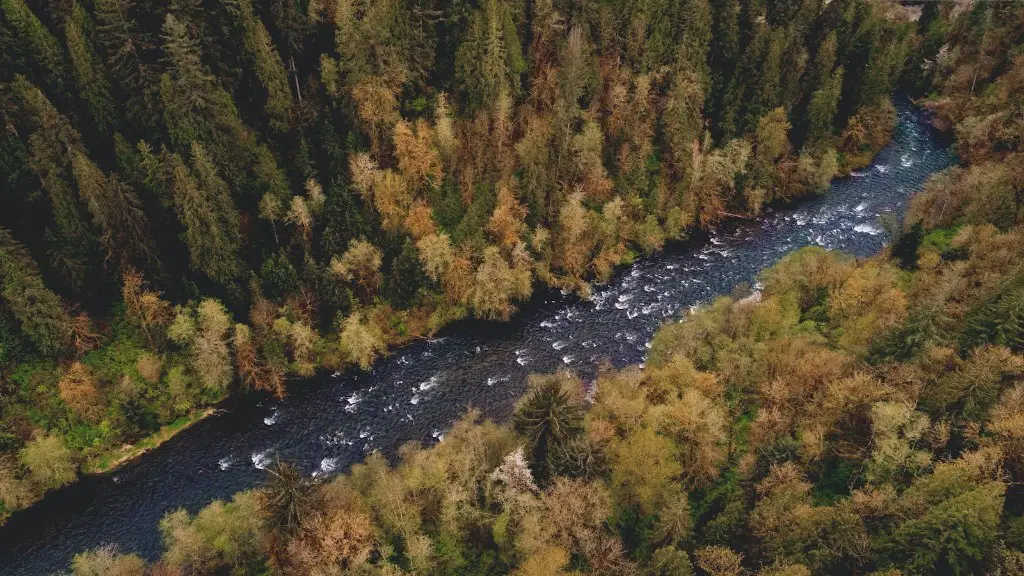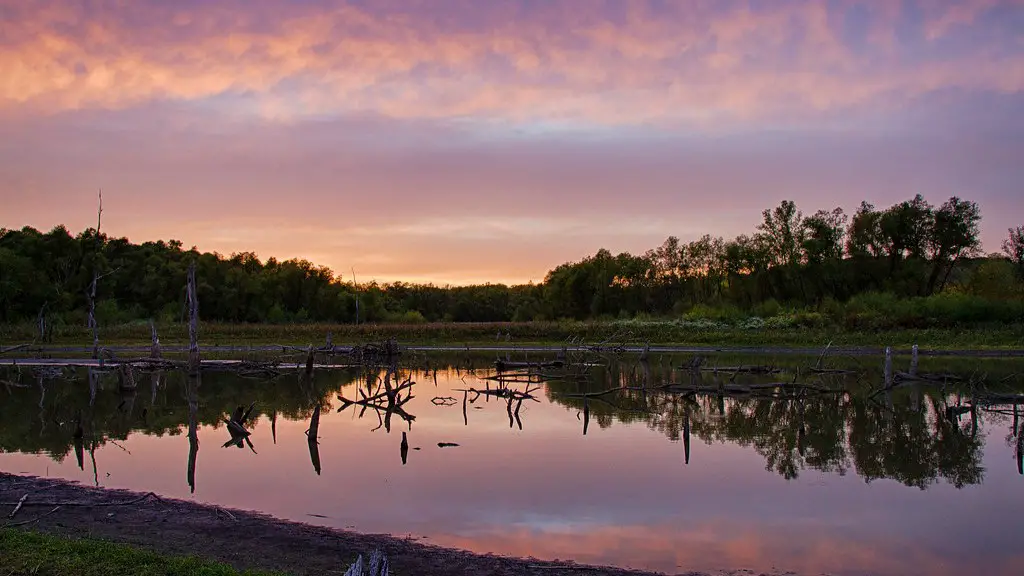The Mississippi River drainage basin is one of the largest in the world and drains more than 31 states in the United States. As a major river system, the Mississippi and its tributaries support enormous human population centers, provide important navigation channels and are key elements in flood control. With an enormous water-holding capacity and a large area of coverage, the Mississippi River drainage basin plays an important part in the movement of goods, services and resources in the United States.
The Mississippi River itself is the largest river in the U.S. and its tributaries, the Missouri and Ohio Rivers, represent the fourth and fifth largest rivers. In addition, the Mississippi River and its tributaries provide valuable ecosystems for numerous species of fish and wildlife. The Mississippi also plays an important role in flood control through its many reservoirs, as well as controlling erosion of the banks of the river.
Geographically, the Mississippi River is located in the middle of the United States. It runs from its headwaters in Minnesota, through the entire Midwest, down to the Gulf of Mexico. It forms the northern border of several states, including Oklahoma, Missouri, Arkansas, and Mississippi. The Mississippi River extends approximately 2,400 miles, making it the longest river in the United States.
The drainage basin of the Mississippi River is also home to some of the largest of America’s cities, including St. Louis, Memphis, New Orleans, and Minneapolis. Moreover, due to its large geographical area, the Mississippi River contributes to a diverse and vibrant culture, which is reflected in its music, cuisine, art and language.
Due to its size, the drainage basin of the Mississippi River handles a huge volume of water, but also a considerable amount of sediment and other pollutants. The Mississippi and its tributaries are also an important part of the global water cycle, as the river transports nutrients, organic matter and carbon to the Gulf of Mexico. This is an important part of the global environment, as these nutrients and organic matter support local and global ecosystems.
Furthermore, the Mississippi River is an important part of the economy of the United States. Its waters are used for commercial, agricultural and recreational purposes, and the river provides an important channel for the movement of goods and services. The river is also important for hydropower generation and flood control.
In conclusion, the Mississippi River drainage basin plays an important role in the economic and environmental health of the United States. Its size, location and associated tributaries support large populations and a vibrant and diverse culture. As a major river system, the Mississippi provides both recreational and economic benefits, as well as contributing to the global water cycle.
Effects of Pollution and Development
The development of the Mississippi River drainage basin and the impact of pollution on the river have been of concern for a number of years. With intense industrial and agricultural development, the river has had to contend with an extensive array of pollutants, such as fertilizer and animal waste, which are detrimental to the health of the ecosystem. Moreover, the construction of levees and dams, while helping to control flooding, also impinges on the natural cycle of the river.
In addition to the impact of pollution, the river has also experienced various human induced impacts on the local environment. These include sustained dredging of the river which has caused sediment buildup and the proliferation of invasive species that compete with native species and alter the local ecology. Furthermore, the construction of levees, which are designed to protect the region from flooding, has also led to the disruption of the natural floodplain, reducing the amount of nutrients and oxygen reaching the river.
Human activities have also caused an increase in the amount of nitrogen reaching the Gulf of Mexico from the Mississippi River drainage. This nitrogen, which is derived from agricultural runoff and wastewater, is contributing to water quality issues in the Gulf and has led to a decrease in the abundance of fish and other aquatic life. The increasing rate of global warming has also led to decreased winter snowfall and ice melt, contributing to reduced flow levels in the Mississippi River.
In addition to the effects of pollution and development, the Mississippi River drainage basin is also threatened by changes in global climate. Warmer temperatures and changing precipitation can cause extreme weather events, such as floods and droughts, which can have major economic and environmental implications. These events can affect the amount of water reaching the river, as well as the amount of sediment and nutrients being transported to the Gulf.
Management and Mitigation
Various management and mitigation strategies have been implemented to reduce the impacts of pollution, development and climate change on the Mississippi River and its tributaries. In addition to the construction of levees and dams, the US Army Corps of Engineers has implemented nutrient offset programs which involve the adoption of conservation best practices, such as reducing fertilizer use, in order to reduce the amount of nitrogen reaching the Gulf of Mexico.
The US Environmental Protection Agency has also implemented various programs to reduce the amount of wastewater and agricultural runoff reaching the river. This includes the adoption of best management practices by farmers and other agricultural operators, such as the use of buffer strips and retention basins, as well as the implementation of nutrient management plans. The EPA has also implemented regulations to reduce the amount of mercury entering the river, as this pollutant can be detrimental to the health of aquatic life.
In addition to these management and mitigation strategies, there are also various conservation efforts that are being undertaken to restore the health of the river ecosystem. For example, the restoration of the wetlands of the Mississippi Delta involves the reintroduction of native vegetation and the reintroduction of fish species, such as paddlefish and sturgeon. Such efforts are designed to reduce the impacts of pollution, development and climate change and to restore the iconic Mississippi River.
Economy and Tourism
The Mississippi River drainage basin is an important part of the American economy. Its waters provide vital waterways for transportation, and its wetlands provide unique habitats for numerous species of fish and wildlife. The levees and dams also play an important role in flood control, helping to maintain property along the river and reducing damages from flooding.
Moreover, the Mississippi River and its tributaries are an important part of the tourism industry in the United States, providing recreational activities and attractions for visitors. Fishing, canoeing, and camping are just some of the activities that can be enjoyed along the banks of the Mississippi. Additionally, boating is popular along the lower of the river and along the many tributaries.
The Mississippi River and its tributaries also contribute to the culinary culture of the United States, as the river is home to a wide variety of fish species, including bass and catfish. Moreover, the river supports various other forms of wildlife, including bald eagles, ospreys and migrant waterfowl, which attract wildlife enthusiasts and birdwatchers.
Overall, the Mississippi River and its tributaries are vitally important to the economy and environment of the United States. It provides numerous economic benefits and supports invaluable ecosystems. The river is also a resource for recreation and tourism, and is a key component of the cultural identity of the United States.
Impact of Public Action
Public action plays an important role in protecting the Mississippi River and its tributaries. One of the main priorities of the government has been the implementation of regulatory measures to ensure that water quality is maintained and that the river remains healthy. This includes the adoption of laws and regulations to reduce the amount of pollutants reaching the river, as well as the implementation of buffer strips and other conservation best practices.
The public has also been involved in efforts to clean up the river. For example, National River Cleanup Day is a national event where citizens can join together to clear and clean local rivers and streams from pollution. Various non-profit organizations, such as The Nature Conservancy and American Rivers, are also actively involved in efforts to restore the health of the river, by implementing conservation best practices and engaging in advocacy for their mission.
In addition to direct conservation efforts, the public can take action by supporting organizations that are actively involved in protecting the Mississippi River. From donating to non-profit organizations to engaging in political advocacy, the public can play an important role in ensuring that the river remains healthy.
Finally, the public can also take further action to reduce their own impacts on the river. By reducing the amount of wastewater and fertilizer they use and utilizing other conservation best practices, individuals can help to protect the Mississippi River and its tributaries.
Conclusion
The Mississippi River drainage basin plays an important role in the health of the United States. Its waters are vital to navigation and recreation, as well as providing an important channel for the movement of goods and services. The river is also an important part of the national culture, as its rich ecosystems, diverse habitats and cultures support a unique and vibrant identity.
In conclusion, the Mississippi River and its tributaries represent an invaluable resource for the United States, and it is essential that efforts are made to protect its health. From public action to conservation initiatives, individuals, organizations and the government must work together to ensure the long-term sustainability of the river.





